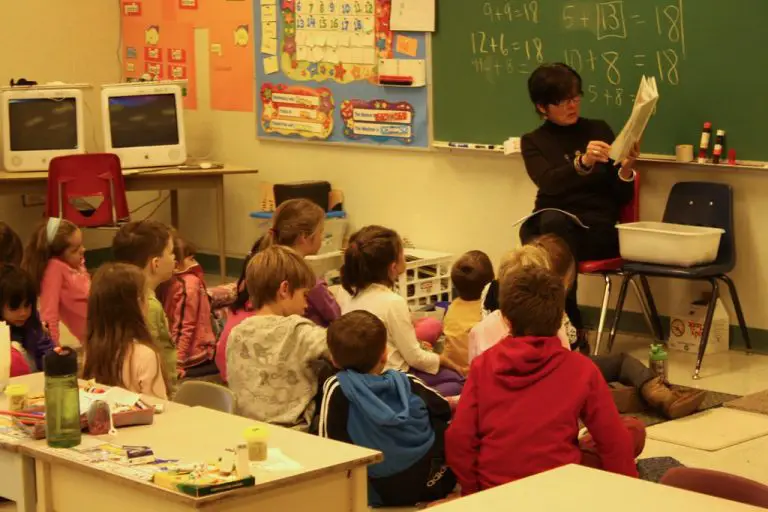Support our educational content for free when you buy through links on our site. Learn more
10 Powerful Ways to Reflect After Teaching a Lesson [2024] 💡
Have you ever felt that “what just happened?” moment after a lesson? 🤯 We’ve all been there! Teaching is a dynamic process, and it’s crucial to take a step back to analyze what worked, what didn’t, and how you can refine your craft for even better student outcomes. In this post, we’ll explore ten powerful strategies for reflecting on your lessons, each one designed to unlock your potential as a teacher and maximize student learning. We’ll delve into journaling techniques, digital tools, and even the value of collaboration – all to help you turn every lesson into a catalyst for growth. Ready to elevate your teaching? Let’s dive in!
Quick Answer
- Reflecting after teaching is essential for professional growth. 📈 It helps you identify strengths, weaknesses, and strategies for improvement.
- Use a variety of reflection techniques such as self-observation, journaling, and digital tools to get a comprehensive view of your lessons.
- Collaborate with colleagues for valuable feedback and new perspectives.
- Embrace mistakes as opportunities for growth and learn from setbacks.
- Reflect on your growth as a teacher by setting goals, tracking progress, and seeking out professional development opportunities.
👉 CHECK PRICE on:
- Lesson Planning Apps: Google Classroom | Canva | SMART Notebook
- Reflective Journal Apps: Google Keep| Evernote
- Online Collaboration Tools: Google Docs | Microsoft Teams
Table of Contents
- Quick Tips and Facts
- The Importance of Reflecting After Teaching: Why it Matters
- Types of Reflections in Teaching
- Effective Reflection Techniques
- Using Reflection in Your Lesson Planning
- Examples of Reflection Questions
- The Power of Collaboration in Reflection
- Mistakes, Setbacks and Growth
- Reflecting on Your Growth as a Teacher
- Building Self-Awareness
- Conclusion
- Recommended Links
- FAQ
- Reference Links
Quick Tips and Facts
- Reflecting on each lesson you teach is essential for growth.
It’s like a workout for your teaching muscles! 💪 - Reflection helps you identify what’s working and what needs tweaking. 🚀
Think of it as a roadmap to becoming a better teacher. - Reflection doesn’t have to be time-consuming . ⏰
Quick and focused reflection can be just as effective. - Be honest with yourself . 🙋♀️
It’s okay to admit when something didn’t go as planned. - Use reflection to celebrate your successes . 🎉
High-five yourself for a great lesson!
The Importance of Reflecting After Teaching: Why it Matters
Reflecting on your teaching helps you refine your craft and maximize student learning. 🧠 It’s not just about the “what” of teaching, but also the “how” and “why.”
Imagine this: You’re designing a lesson on fractions. Your goal is to have students understand equivalent fractions. After the lesson, you spend a few minutes reflecting. Maybe you realize that the activity you used to introduce the concept was a bit confusing for some students. By reflecting, you can identify this issue and adjust the lesson for next time.
Think of reflection as a spiral of continuous improvement. 🔄 You begin with a plan, teach the lesson, reflect on what worked and what didn’t, and then use this insight to adjust your approach for future lessons.
Here are some key benefits of reflecting after teaching:
- Improve Your Teaching: Reflection helps you identify strengths and weaknesses in your teaching style. It can help you improve your instructional strategies, classroom management, and overall effectiveness.
- Enhance Student Learning: By reflecting on your teaching, you can identify areas where students struggled and adjust your instruction to meet their needs. You’ll be able to better differentiate your teaching and cater to various learning styles.
- Boost Your Confidence: Reflection can help you feel more confident and secure in your teaching abilities. It allows you to celebrate your successes and analyze areas that need further development.
- Become a More Reflective Practitioner: Reflection is a critical component of professional development. It’s an ongoing process that helps you become a more thoughtful and strategic educator.
Types of Reflections in Teaching
There are different types of reflections, each serving a unique purpose in improving your teaching:
- Pre-Lesson Reflection: Even before teaching a lesson, it’s beneficial to reflect on your objectives, materials, and potential challenges. This pre-planning helps you prepare for a smooth and engaging learning experience.
- During-Lesson Reflection: This is where you observe student responses and make adjustments in real-time. You can check for understanding and modify the lesson to address any confusion.
- Post-Lesson Reflection: This is the most common type of reflection where you examine the effectiveness of your lesson. It allows you to analyze the successes, challenges, and what you can improve for next time.
These various types of reflection are interconnected. Each plays a crucial role in shaping your overall pedagogy.
Effective Reflection Techniques
There are many ways to reflect on your teaching. Some popular techniques include:
Observation Techniques
Observing your teaching can provide valuable insights.
- Self-Observation: This can be as simple as pausing during a lesson to notice how students are responding. You can also ask yourself questions like:
- Are students engaged?
- Are they struggling with certain concepts?
- Am I using a variety of teaching strategies?
- Peer Observation: Having a colleague observe your lesson can offer a fresh perspective. They can provide feedback on your instructional strategies, classroom management, and student engagement.
- Student Feedback: Get feedback from your students! You can use a quick exit ticket, a survey, or a class discussion to gather their thoughts on the lesson.
**✅ Use a combination of these observation techniques for a comprehensive view of your teaching. **
Journaling Techniques
Journaling allows you to process your thoughts and reflect on your lessons in a structured way.
- Write a Lesson Reflection: Document your thoughts and observations about the lesson. Be specific about what worked, what didn’t, and why. There are many journaling prompts you can use, such as:
- What were the learning objectives for this lesson?
- What instructional strategies did I use?
- How well did students understand the material?
- What went well in this lesson?
- What could I improve on next time?
- Keep a Teaching Journal: Make a habit of writing down your reflections regularly. This allows you to track your progress and identify patterns in your teaching over time.
✅ Use a reflective journal app like Google Keep or Evernote
Digital Tools
Using digital tools streamlines reflection and makes it easier to access your insights later.
- Lesson Planning Apps: Apps like Google Classroom, Canva, and SMART Notebook allow you to plan your lessons digitally and make quick adjustments while you teach. Some even have built-in reflection features that let you capture observations and notes.
- Video Recording: Recording your lessons can be an effective way to analyze your teaching style and observe your interactions with students. You can review the recording and ask yourself questions about instructional strategies, classroom management, and student engagement. You can even share the video with a colleague or mentor for feedback.
- Online Collaboration Tools: Use platforms like Google Docs or Microsoft Teams to collaborate with colleagues on co-planning and reflecting on lessons. This allows you to share your insights, receive feedback, and benefit from different perspectives.
**✅ Experiment with different tools to find what works best for you. **
Using Reflection in Your Lesson Planning
Reflection doesn’t end after your lesson. It helps you craft future lessons.
- Start with Your Learning Goals: What do you want students to learn from the lesson? Be specific about the objectives.
- Consider Your Audience: Think about your students’ learning styles and prior knowledge.
- Choose Your Strategies: Select teaching methods that will effectively address the learning objectives and engage your students.
- Plan for Differentiation: How will you cater to students with different learning needs?
- Select Assessment Tools: Design formative assessments to monitor student progress and understanding during the lesson.
- Reflect on Your Previous Lessons: How can you apply past experiences to this new lesson? What worked, what didn’t, and how can you adapt your approach?
✅ The more you reflect, the more purposeful and impactful your lesson planning will become.
Examples of Reflection Questions
Here are some general questions to guide your reflection:
- What was the overall goal of my lesson?
- What instructional strategies did I use?
- How did they work for the students?
- What evidence did I gather to assess student learning?
- How did I address individual learning needs?
- What feedback did I get from students?
- What worked well?
- What could I improve next time?
✅ Develop a set of reflection questions that specifically address your teaching context and subject area.
The Power of Collaboration in Reflection
Reflecting with colleagues can be powerful.
- Share your observations: Discuss your lessons with colleagues, and share your insights about what worked, what didn’t, and what you learned.
- Get feedback on your teaching: Ask for specific feedback. Maybe you’re struggling with a certain aspect of your teaching, or you want to try out a new strategy.
- Gain different perspectives: Observing others teach and reflecting on their lessons can provide new perspectives on how to approach your own teaching.
- Learn from each other: Collaborative reflection can be a powerful tool for professional development and growth.
✅ Find a colleague or mentor who can provide you with constructive feedback.
Mistakes, Setbacks and Growth
Don’t let mistakes derail your growth!
- Acknowledge your mistakes: It’s normal to make mistakes. Being willing to admit and learn from them is important.
- View mistakes as learning opportunities: Every setback holds potential for growth.
- Seek support: If you’re struggling with a particular aspect of your teaching, reach out to a mentor or colleague for guidance and support.
- Celebrate your successes: Remember to acknowledge your accomplishments! Even small victories are worth celebrating.
**✅ Mistakes are part of the learning process. Don’t be afraid to make them! **
Reflecting on Your Growth as a Teacher
Reflection helps you grow as a professional.
- Set goals: What are your professional goals for the year?
- Track your progress: Monitor your growth over time.
- Seek out professional development opportunities: Attend workshops or take courses to enrich your skills and knowledge.
- Be patient with yourself: You won’t see results overnight.
✅ Remember that teaching is a lifelong journey of learning and growth.
Building Self-Awareness
Reflection is key to understanding yourself as a teacher and improving your practice.
- Identify your strengths: What are you good at? What skills do you excel in?
- Acknowledge your weaknesses: What are areas where you could improve?
- Develop your self-reflection skills: Think about how you can make reflection a regular habit in your teaching practice.
✅ Embrace the journey of self-discovery and continuous improvement!
Conclusion

Reflecting on your teaching is an essential part of becoming a better educator. It’s not just about analyzing your lessons; it’s about becoming more self-aware, taking ownership of your growth, and building a deeper understanding of your craft.
Remember, reflecting is a journey, not a destination. By embracing reflection, you’ll unlock your potential as a teacher and create a more meaningful and impactful learning experience for your students. 🤩
Recommended Links
👉 CHECK PRICE on:
- SMART Notebook: Amazon | SMART Technologies Official
- Google Classroom: Google Workspace | Google For Education
- Canva: Amazon | Canva Official
- Google Keep: Google Workspace | Google Keep Website
- Evernote: Amazon | Evernote Official
- Google Docs: Google Workspace | Google Docs Website
- Microsoft Teams: Microsoft Website
- Reflecting on Teaching: A Guide for Educators: Amazon
- The Reflective Practitioner: Amazon
FAQ

How do you write a reflection after teaching?
There’s no one-size-fits-all approach, but here’s a simple structure that can help:
- Start with a brief overview: Revisit the lesson’s objective and the key learning points.
- Outline what went well: Identify the successes and highlight moments where students were engaged and learning.
- Acknowledge challenges: Be truthful about areas where things didn’t go as planned.
- Reflect on student engagement: How engaged were students with the lesson? Did it meet their learning needs?
- Consider your instructional strategies: Did you use a variety of methods? Was the pace appropriate?
- Analyze assessment results: How did students perform on formative and summative assessments?
- Identify areas for improvement: What could you change to make this lesson even better next time?
- Action Steps: Plan specific changes to your teaching practices based on your reflection.
Read more about “Mastering the 4A’s Framework: Crafting Engaging English Lessons for Grade 7 … 🏫”
What should a teacher reflect on a taught lesson?
Think about these key areas:
- Learning objectives: Were the objectives achieved? Were they relevant and meaningful to students?
- Instructional Strategies: Did your teaching methods engage students and make learning fun?
- Student Learning: Did students understand the material?
- Assessment: How did you assess student learning? Were the assessments meaningful?
- Classroom Management: How well did you manage the classroom? Were there any disruptions or challenges?
- Differentiation: Did you meet the needs of all learners in your classroom?
- Your Teaching Strengths: What worked well in this lesson? What are you proud of?
- Areas for Improvement: What could you do differently next time? What could you improve on?
What are examples of reflection for teachers?
Here are some relatable examples:
- You planned a captivating activity for a history lesson. You observed students excited and engaged, actively participating in the activity. Your reflection notes highlight the success of this strategy and its positive impact on student learning.
- You presented a concept in a challenging science lesson, and you noticed some students struggled. You reflect on the strategies you used and realize you can simplify the explanations.
- While teaching a creative writing lesson, you notice students were excited about sharing their stories but seemed nervous. You learn from this and make a plan to encourage and support their creativity in future lessons.
What is a good teacher reflection?
A good teacher reflection is:
- Honest
- Specific
- Actionable
- Focused
- Thoughtful
- Student-centered
- Growth-oriented
Reference Links
- SMART Technologies: https://www.smarttech.com/
- Google Workspace: https://workspace.google.com/
- Canva: https://www.canva.com/es_419/
- Google Keep: https://keep.google.com/
- Evernote: https://evernote.com/
- Google Docs: https://docs.google.com/
- Microsoft Teams: https://www.microsoft.com/en-us/microsoft-365/microsoft-teams
- Lesson Plan Self reflection and Assessment: https://www.saintt.com/documents/2017/9/LessonPlanReflectionAssessment.pdf
- Association for Supervision and Curriculum Development: https://www.ascd.org/
- National Education Association: https://www.nea.org/

